Capability Analysis of Earth Observation Data for Integrated Emergency Management
Abstract
:1. Introduction
- What satellite data are available to support impact assessment of snow, fire and electricity transmission incidents?
- How can satellite data support emergency management of these incidents?
- What are the challenges and limitations in currently available satellite data for managing each incident type?
2. Conceptual Foundations
2.1. Climate Change Impacts on the Environment and Society
2.2. Additional Anthropogenic Impacts on the Environment and Society
2.3. Integrated Emergency Management Framework in the UK
2.4. Data Platforms and Providers of Satellite-Derived Information for Emergency Management
3. Methodology
3.1. Study Area
3.2. R2-D2 Project Structure
- WP 1: Working group establishment and stakeholder workshop
- WP 2: Capability audit and outline data
- WP 3: Local piloting and business case development
4. R2-D2 Case Study Results
4.1. Previous Use of Satellite Imagery for Managing Selected Emergency Management Situations
4.2. Available Data for Impact Assessment of Selected Incidents
- Visualising where snow is covering key infrastructure;
- Identifying potentially illegal dumping sites and legal dumping sites acting outside of their specifications;
- Identifying fallen trees and using light and dark nighttime images to show areas experiencing power outages.
4.3. Pilot Studies Investigating Satellite Imagery in Support of Emergency Management
4.3.1. Snow and Extreme Cold Incidents
4.3.2. IWS Fire
4.3.3. Electricity Transmission Faults
4.4. Synthesis
- (1)
- Menu with dashboard views for the different risks: Snow and extreme cold, electricity transmission faults and IWS fires. Further potential work includes integrating a public reporting tool and social media integration using public channels from authorities, such as Northern PowerGrid reporting to customers on current incidents using the platform X (formerly Twitter).
- (2)
- List of different datasets for location-based analyses. Examples of layers include raw data acquired directly from the source and post-processed analysis results.
- (3)
- Satellite image view of the former Alex Smiles Limited recycling facility in Deptford Terrace, Sunderland.
- (4)
- View of the human vulnerability layer visualises resilience and vulnerability scores using datasets defined in Table 1.
5. Discussion on Recommendations for Utilising Satellite Data for Integrated Emergency Management
- Implement change detection analysis for emergency incidents:
- Integrate social data for enhanced risk analysis:
- Conduct vulnerability analysis:
- Data fusion:
- Develop geospatial dashboard solution with advanced analyses:
- Collaborate with emergency agencies for improved data availability:
- Data availability:
- Spectral resolution:
- Temporal resolution:
- Data fragmentation:
- Data volume and processing:
- Dependency on external software for advanced processing:
- Nighttime light satellite data:
6. Conclusions
Author Contributions
Funding
Data Availability Statement
Acknowledgments
Conflicts of Interest
References
- UK Space Agency. Size and Health of the UK Space Industry 2023. 2024. Available online: https://assets.publishing.service.gov.uk/media/66a366e2a3c2a28abb50d7aa/Size_and_Health_of_the_UK_Space_Industry_2023.pdf (accessed on 30 January 2025).
- UK Government. National Space Strategy. 2022. Available online: https://www.gov.uk/government/publications/national-space-strategy/national-space-strategy (accessed on 30 January 2025).
- UK Space Agency. Announcement of Opportunity: Enabling Technologies Programme—Call One. 2022. Available online: https://www.gov.uk/government/publications/announcement-of-opportunity-enabling-technologies-programme-call-one/announcement-of-opportunity-enabling-technologies-programme-call-one (accessed on 30 January 2025).
- IPCC. Climate Change 2022: Impacts, Adaptation, and Vulnerability; Contribution of Working Group II to the Sixth Assessment Report of the Intergovernmental Panel on Climate Change; Pörtner, H.-O., Roberts, D.C., Tignor, M., Poloczanska, E.S., Mintenbeck, K., Alegría, A., Craig, M., Langsdorf, S., Löschke, S., Möller, V., et al., Eds.; Cambridge University Press: Cambridge, UK; New York, NY, USA, 2022. [Google Scholar] [CrossRef]
- Hajat, S.; Chalabi, Z.; Wilkinson, P.; Erens, B.; Jones, L.; Mays, N. Public health vulnerability to wintertime weather: Time-series regression and episode analyses of national mortality and morbidity databases to inform the Cold Weather Plan for England. Public Health 2016, 137, 26–34. [Google Scholar] [CrossRef]
- Gasparrini, A.; Masselot, P.; Scortichini, M.; Schneider, R.; Mistry, M.N.; Sera, F.; Macintyre, H.L.; Phalkey, R.; Vicedo-Cabrera, A.M. Small-area assessment of temperature-related mortality risks in England and Wales: A case time series analysis. Lancet Planet. Health 2022, 6, e557–e564. [Google Scholar] [CrossRef]
- Guertler, P.; Smith, P. Cold Homes and Excess Winter Deaths: A Preventable Public Health Epidemic that Can no Longer be Tolerated. JSTOR. 2018, p. E3G. Available online: https://www.jstor.org/tc/accept?origin=%2Fstable%2Fpdf%2Fresrep17843.pdf&is_image=False (accessed on 30 January 2025).
- Zhang, W.; Wang, N. Resilience-based risk mitigation for road networks. Struct. Saf. 2016, 62, 57–65. [Google Scholar] [CrossRef]
- Karlsson, C.S.; Kalantari, Z.; Mörtberg, U.; Olofsson, B.; Lyon, S.W. Natural hazard susceptibility assessment for road planning using spatial multi-criteria analysis. Environ. Manag. 2017, 60, 823–851. [Google Scholar] [CrossRef]
- Kelsall, D.; Redelmeier, D.A. Winter road safety is no accident. Cmaj 2016, 188, 241. [Google Scholar] [CrossRef] [PubMed]
- Jacobsen, J.K.S.; Leiren, M.D.; Saarinen, J. Natural hazard experiences and adaptations: A study of winter climate-induced road closures in Norway. Nor. Geogr. Tidsskr.-Nor. J. Geogr. 2016, 70, 292–305. [Google Scholar] [CrossRef]
- Akour, M.; Al Qasem, O.; Hanandeh, F. Traffic Accident Severity Prediction: A comparison Study. Int. J. Transp. Syst. 2022, 7, 24–28. [Google Scholar]
- Bougna, T.; Hundal, G.; Taniform, P. Quantitative analysis of the social costs of road traffic crashes literature. Accid. Anal. Prev. 2022, 165, 106282. [Google Scholar] [CrossRef]
- Panteli, M.; Mancarella, P. Influence of extreme weather and climate change on the resilience of power systems: Impacts and possible mitigation strategies. Electr. Power Syst. Res. 2015, 127, 259–270. [Google Scholar] [CrossRef]
- National Grid. Standards of Performance. 2025. Available online: https://www.nationalgrid.co.uk/customers-and-community/standards-of-performance#:~:text=During%20lightning%20events%2C%20where%20the,failure%20payment%20to%20the%20customer (accessed on 30 January 2025).
- Met Office. Storm Desmond. 2015. Available online: https://www.metoffice.gov.uk/weather/warnings-and-advice/uk-storm-centre/storm-desmond (accessed on 30 January 2025).
- Met Office. Beast from the East. 2018. Available online: https://www.metoffice.gov.uk/weather/learn-about/weather/atmosphere/air-masses/beast-from-the-east (accessed on 30 January 2025).
- Met Office. Storm Arwen Named. 2021. Available online: https://www.metoffice.gov.uk/about-us/news-and-media/media-centre/weather-and-climate-news/2021/storm-arwen-named (accessed on 30 January 2025).
- Ofgem. Final Report on the Review into Network’ Response to Storm Arwen. 2022. Available online: https://www.ofgem.gov.uk/sites/default/files/2022-06/Final%20report%20on%20the%20review%20into%20the%20networks%27%20response%20to%20Storm%20Arwen.pdf (accessed on 30 January 2025).
- Met Office. Recent Trends and Future Projections of UK Storm Activity. 2021. Available online: https://www.metoffice.gov.uk/research/news/2021/recent-trends-and-future-projections-of-uk-storm-activity (accessed on 30 January 2025).
- Ichinose, D.; Yamamoto, M. On the relationship between the provision of waste management service and illegal dumping. Resour. Energy Econ. 2011, 33, 79–93. [Google Scholar] [CrossRef]
- Ibrahim, M.F.; Hod, R.; Toha, H.R.; Mohammed Nawi, A.; Idris, I.B.; Mohd Yusoff, H.; Sahani, M. The impacts of illegal toxic waste dumping on children’s health: A review and case study from Pasir Gudang, Malaysia. Int. J. Environ. Res. Public Health 2021, 18, 2221. [Google Scholar] [CrossRef] [PubMed]
- Limoli, A.; Garzia, E.; De Pretto, A.; De Muri, C. Illegal landfill in Italy (EU)—A multidisciplinary approach. Environ. Forensics 2019, 20, 26–38. [Google Scholar] [CrossRef]
- Morrissey, D.; Hess, M.; Watson, H. National Waste Crime Survey Report 2021—Findings and Analysis; Environment Agency. 2021. Available online: https://assets.publishing.service.gov.uk/media/615b39358fa8f529834947ab/National_waste_crime_survey_report_2021_-_report.pdf (accessed on 30 January 2025).
- Cabinet Office. Emergency Response and Recovery. Non Statutory Guidance Accompanying the Civil Contingencies Act 2004. 2013. Available online: https://assets.publishing.service.gov.uk/government/uploads/system/uploads/attachment_data/file/253488/Emergency_Response_and_Recovery_5th_edition_October_2013.pdf (accessed on 30 January 2025).
- European Space Agency. Sentinel-2. 2025. Available online: https://sentiwiki.copernicus.eu/web/sentinel-2 (accessed on 30 January 2025).
- Airbus. Our Optical and Radar High-Resolution Satellite Imagery, the most comprehensive Constellation of commercial optical and radar Earth Observation Satellites. 2025. Available online: https://space-solutions.airbus.com/imagery/optical-radar-satellite-imagery/ (accessed on 30 January 2025).
- NASA. Terra & Aqua Moderate Resolution Imaging Spectroradiometer (MODIS). 2024. Available online: https://ladsweb.modaps.eosdis.nasa.gov/missions-and-measurements/modis/#:~:text=MODIS%20data%20products%2C%20in%20three,and%20in%20the%20lower%20atmosphere (accessed on 30 January 2025).
- European Space Agency. Sentinel-1. 2025. Available online: https://sentiwiki.copernicus.eu/web/sentinel-1 (accessed on 15 March 2023).
- European Centre for Medium-Range Weather Forecasts (ECMWF). ERA5-Land. 2025. Available online: https://www.ecmwf.int/en/era5-land (accessed on 30 January 2025).
- LiveEO. Unlock the potential of Earth Observation. 2025. Available online: https://www.live-eo.com/ (accessed on 30 January 2025).
- Sile. Space Based Infrastructure Monitoring. 2025. Available online: https://www.sille.space/en/ (accessed on 30 January 2025).
- Everbridge. Everbridge Keeps Your People Safe and Your Organization Running. 2025. Available online: https://www.everbridge.com/ (accessed on 30 January 2025).
- ICEEYE. Accurate, Near Real-Time Earth Monitoring with SAR Data. 2025. Available online: https://www.iceye.com/sar-data (accessed on 30 January 2025).
- MAXAR. Satellite Imagery and Multi-INT Collection. 2025. Available online: https://www.maxar.com/maxar-intelligence/products/satellite-imagery (accessed on 30 January 2025).
- Telespazio Vega. Disaster Management. 2025. Available online: https://telespazio.co.uk/en/markets/disaster-management (accessed on 30 January 2025).
- Office for National Statistics. Estimates of the Population for England and Wales. 2023. Available online: https://www.ons.gov.uk/peoplepopulationandcommunity/populationandmigration/populationestimates/datasets/estimatesofthepopulationforenglandandwales (accessed on 10 March 2023).
- Hall, D.K.; Riggs, G.; Román, M.O. VIIRS Snow Cover Algorithm Theoretical Basis Document. 2015. Available online: http://modis-snow-ice.gsfc.nasa.gov/uploads/VIIRS_snow_cover_ATBD_2015.pdf?_ga=2.113947655.1257306268.1679576062-2442.218691736.1678710481 (accessed on 30 January 2025).
- Hall, D.K.; Riggs, G.A.; Salomonson, V.V. Development of methods for mapping global snow cover using moderate resolution imaging spectroradiometer data. Remote Sens. Environ. 1995, 54, 127–140. [Google Scholar] [CrossRef]
- Snapir, B.; Momblanch, A.; Jain, S.K.; Waine, T.W.; Holman, I.P. A method for monthly mapping of wet and dry snow using Sentinel-1 and MODIS: Application to a Himalayan river basin. Int. J. Appl. Earth Obs. Geoinf. 2019, 74, 222–230. [Google Scholar] [CrossRef]
- Lievens, H.; Demuzere, M.; Marshall, H.P.; Reichle, R.H.; Brucker, L.; Brangers, I.; de Rosnay, P.; Dumont, M.; Girotto, M.; Immerzeel, W.W.; et al. Snow depth variability in the Northern Hemisphere mountains observed from space. Nat. Commun. 2019, 10, 4629. [Google Scholar] [CrossRef] [PubMed]
- Buchelt, S.; Skov, K.; Rasmussen, K.K.; Ullmann, T. Sentinel-1 time series for mapping snow cover depletion and timing of snowmelt in Arctic periglacial environments: Case study from Zackenberg and Kobbefjord, Greenland. Cryosphere 2022, 16, 625–646. [Google Scholar] [CrossRef]
- Foster, J.L.; Hall, D.K.; Chang, A.T.C.; Rango, A. An overview of passive microwave snow research and results. Rev. Geophys. 1984, 22, 195–208. [Google Scholar] [CrossRef]
- Nagler, T.; Rott, H.; Ripper, E.; Bippus, G.; Hetzenecker, M. Advancements for snowmelt monitoring by means of Sentinel-1 SAR. Remote Sens. 2016, 8, 348. [Google Scholar] [CrossRef]
- Ulaby, F.T.; Stiles, W.H.; Abdelrazik, M. Snowcover influence on backscattering from terrain. IEEE Trans. Geosci. Remote Sens. 1984, 2, 126–133. [Google Scholar] [CrossRef]
- Gill, J.; Faisal, K.; Shaker, A.; Yan, W.Y. Detection of waste dumping locations in landfill using multi-temporal Landsat thermal images. Waste Manag. Res. 2019, 37, 386–393. [Google Scholar] [CrossRef]
- Zhao, X.; Yang, Y.; Duan, F.; Zhang, M.; Jiang, G.; Yan, X.; Cao, S.; Zhao, W. Identification of construction and demolition waste based on change detection and deep learning. Int. J. Remote Sens. 2022, 43, 2012–2028. [Google Scholar] [CrossRef]
- Hosseini, M.; Lim, S. Burned area detection using Sentinel-1 SAR data: A case study of Kangaroo Island, South Australia. Appl. Geogr. 2023, 151, 102854. [Google Scholar] [CrossRef]
- Rajkumar, A.; Kft, C.A.; Sziranyi, T.; Majdik, A. Detecting Landfills Using Multi-Spectral Satellite Images and Deep Learning Methods. Proc. ICLR. 2022. Available online: https://pml4dc.github.io/iclr2022/pdf/PML4DC_ICLR2022_9.pdf (accessed on 30 January 2025).
- Yan, W.Y.; Mahendrarajah, P.; Shaker, A.; Faisal, K.; Luong, R.; Al-Ahmad, M. Analysis of multi-temporal landsat satellite images 2036 for monitoring land surface temperature of municipal solid waste disposal sites. Environ. Monit. Assess. 2014, 186, 8161–8173. [Google Scholar] [CrossRef]
- NASA. MODIS Vegetation Index Products (NDVI and EVI). 2025. Available online: https://modis.gsfc.nasa.gov/data/dataprod/mod13.php (accessed on 30 January 2025).
- Mahmood, K.; Ul-Haq, Z.; Faizi, F.; Tariq, S.; Naeem, M.A.; Rana, A.D. Monitoring open dumping of municipal waste in Gujranwala, Pakistan using a combination of satellite based bio-thermal indicators and GIS analysis. Ecol. Indic. 2019, 107, 105613. [Google Scholar] [CrossRef]
- Mahmood, K.; Ul-Haq, Z.; Faizi, F.; Batol, S.A. A comparison of satellite-based indices for hazard assessment of MSW open dumps using spatial analysis. Waste Manag. Res. 2019, 37, 219–236. [Google Scholar] [CrossRef] [PubMed]
- Gazzea, M.; Pacevicius, M.; Dammann, D.O.; Sapronova, A.; Lunde, T.M.; Arghandeh, R. Automated power lines vegetation monitoring using high-resolution satellite imagery. IEEE Trans. Power Deliv. 2021, 37, 308–316. [Google Scholar] [CrossRef]
- Hartling, S.; Sagan, V.; Maimaitijiang, M.; Dannevik, W.; Pasken, R. Estimating tree-related power outages for regional utility network using airborne LiDAR data and spatial statistics. Int. J. Appl. Earth Obs. Geoinf. 2021, 100, 102330. [Google Scholar] [CrossRef]
- Matikainen, L.; Lehtomäki, M.; Ahokas, E.; Hyyppä, J.; Karjalainen, M.; Jaakkola, A.; Kukko, A.; Heinonen, T. Remote sensing methods for power line corridor surveys. ISPRS J. Photogramm. Remote Sens. 2016, 119, 10–31. [Google Scholar] [CrossRef]
- Cole, T.A.; Wanik, D.W.; Molthan, A.L.; Román, M.O.; Griffin, R.E. Synergistic use of nighttime satellite data, electric utility infrastructure, and ambient population to improve power outage detections in urban areas. Remote Sens. 2017, 9, 286. [Google Scholar] [CrossRef]
- Shah, Z.; Hsu, F.C.; Elvidge, C.D.; Taneja, J. Mapping Disasters & Tracking Recovery in Conflict Zones Using Nighttime Lights. In Proceedings of the 2020 IEEE Global Humanitarian Technology Conference (GHTC), Seattle, WA, USA, 29 October–1 November 2020; pp. 1–8. [Google Scholar] [CrossRef]
- Hall, D.K.; Riggs, G.A. MODIS/Terra Snow Cover Daily L3 Global 500m SIN Grid; (MOD10A1, Version 6). [Data Set]; NASA National Snow and Ice Data Center Distributed Active Archive Center: Boulder, CO, USA, 2016. [Google Scholar] [CrossRef]
- European Space Agency. Sentinel-1 SAR GRD: C-Band Synthetic Aperture Radar Ground Range Detected, Log Scaling. 2023. Available online: https://developers.google.com/earth-engine/datasets/catalog/COPERNICUS_S1_GRD (accessed on 26 March 2023).
- Office for National Statistics. Lower layer Super Output Areas (December 2021) Boundaries EW BFE (V10). 2023. Available online: https://geoportal.statistics.gov.uk/datasets/ons::lower-layer-super-output-areas-december-2021-boundaries-ew-bfe-v10-2/about (accessed on 30 January 2025).
- Care Homes. Find a Care Home. 2023. Available online: https://www.cqc.org.uk/care-services/find-care-home (accessed on 15 March 2023).
- Northern Powergrid. Power Cuts. 2023. Available online: https://www.northernpowergrid.com/power-cuts-map (accessed on 15 March 2023).
- Met Office Warnings. Weather and Advice. 2023. Available online: https://weather.metoffice.gov.uk/warnings-and-advice (accessed on 31 March 2025).
- Visual Crossing. Weather Data & API. 2023. Available online: https://www3.visualcrossing.com/ (accessed on 30 January 2025).
- NASA. VNP46A2: VIIRS Lunar Gap-Filled BRDF Nighttime Lights Daily L3 Global 500m. 2025. Available online: https://developers.google.com/earth-engine/datasets/catalog/NOAA_VIIRS_001_VNP46A2 (accessed on 30 January 2025).
- European Centre for Medium-Range Weather Forecasts. ECMWF Reanalysis v5. 2025. Available online: https://www.ecmwf.int/en/forecasts/dataset/ecmwf-reanalysis-v5 (accessed on 30 January 2025).
- Buchhorn, M.; Smets, B.; Bertels, L.; Roo, B.D.; Lesiv, M.; Tsendbazar, N.E.; Herold, M.; Fritz, S. Copernicus Global Land Service: 2131 Land Cover 100m: Collection 3: Epoch 2019: Globe, 2020. 2020. Available online: https://zenodo.org/records/3939050 (accessed on 30 January 2025).
- Ordnance Survey. OS MasterMap Highways Network. 2022. Available online: https://digimap.edina.ac.uk/ (accessed on 10 February 2023).
- Met Office. Severe Winter Weather and Storm Darcy, February 2021. 2021. Available online: https://www.metoffice.gov.uk/binaries/content/assets/metofficegovuk/pdf/weather/learn-about/uk-past-events/interesting/2021/2021_02_low_temperatures.pdf (accessed on 30 January 2025).
- Tsai, Y.L.S.; Dietz, A.; Oppelt, N.; Kuenzer, C. Remote Sensing of Snow Cover Using Spaceborne SAR: A Review. Remote Sens. 2019, 11, 1456. [Google Scholar] [CrossRef]
- Dasari, K.; Anjaneyulu, L.; Jayasri, P.; Prasad, A. Importance of Speckle Filtering in Image Classification of SAR Data. In Proceedings of the 2015 International Conference on Microwave, Optical and Communication Engineering (ICMOCE), Bhubaneswar, India, 18–20 December 2015; pp. 349–352. [Google Scholar] [CrossRef]
- Canty, M.J.; Nielsen, A.A.; Conradsen, K.; Skriver, H. Statistical Analysis of Changes in Sentinel-1 Time Series on the Google Earth Engine. Remote Sens. 2020, 12, 46. [Google Scholar] [CrossRef]
- Gorelick, N.; Hancher, M.; Dixon, M.; Ilyushchenko, S.; Thau, D.; Moore, R. Google Earth Engine: Planetary-scale geospatial 2084 analysis for everyone. Remote Sens. Environ. 2017, 202, 18–27. [Google Scholar] [CrossRef]
- Canty, M.J. Image Analysis, Classification and Change Detection in Remote Sensing: With Algorithms for Python, 4th ed.; CRC Press: Boca Raton, FL, USA, 2019. [Google Scholar]
- Conradsen, K.; Nielsen, A.; Schou, J.; Skriver, H. A test statistic in the complex Wishart distribution and its application to change detection in polarimetric SAR data. IEEE Trans. Geosci. Remote Sens. 2003, 41, 4–19. [Google Scholar] [CrossRef]
- Conradsen, K.; Nielsen, A.A.; Skriver, H. Determining the Points of Change in Time Series of Polarimetric SAR Data. IEEE Trans. Geosci. Remote Sens. 2016, 54, 3007–3024. [Google Scholar] [CrossRef]
- Northern Powergrid. Northern Powergrid Map Shows North East Areas Still Without Power on Day 11. 2021. Available online: https://www.thenorthernecho.co.uk/news/19764492.northern-powergrid-map-shows-north-east-areas-still-without-power-day-11/ (accessed on 30 January 2025).
- Stack Overflow. Most Used Web Frameworks Among Developers Worldwide, as of 2024. Statista Inc.: Hamburg, Germany, 2024. Available online: https://www.statista.com/statistics/1124699/worldwide-developer-survey-most-used-frameworks-web/ (accessed on 27 March 2025).
- Hirpa, F.A.; Salamon, P.; Beck, H.E.; Lorini, V.; Alfieri, L.; Zsoter, E.; Dadson, S.J. Calibration of the Global Flood Awareness 2021 System (GloFAS) using daily streamflow data. J. Hydrol. 2018, 566, 595–606. [Google Scholar] [CrossRef] [PubMed]
- Tod, A.M.; Lusambili, A.; Homer, C.; Abbott, J.; Cooke, J.M.; Stocks, A.J.; McDaid, K.A. Understanding factors influencing vulnerable older people keeping warm and well in winter: A qualitative study using social marketing techniques. BMJ Open 2012, 2, e000922. [Google Scholar] [CrossRef]
- Jones, L.; Mays, N. The experience of potentially vulnerable people during cold weather: Implications for policy and practice. Public Health 2016, 137, 20–25. [Google Scholar] [CrossRef]
- SatVu. High Resolution Thermal Data from Space for a Safer and More Sustainable Earth. 2025. Available online: https://www.satellitevu.com/ (accessed on 31 March 2023).
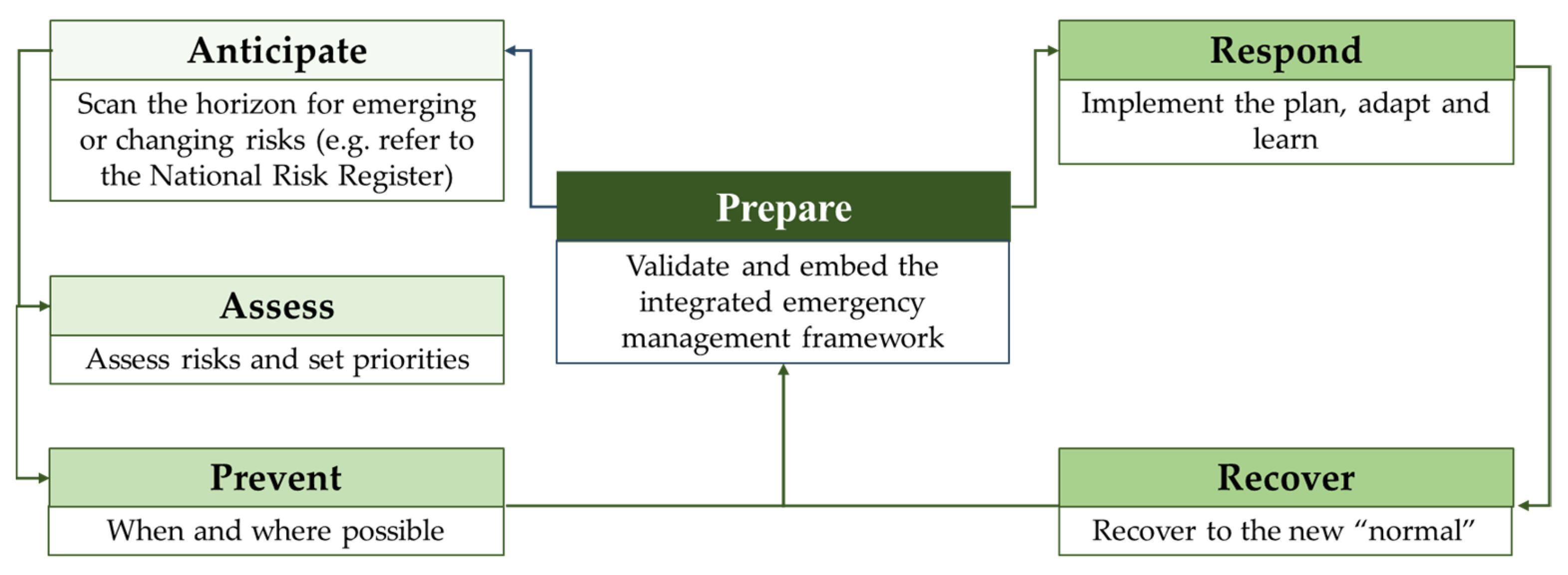

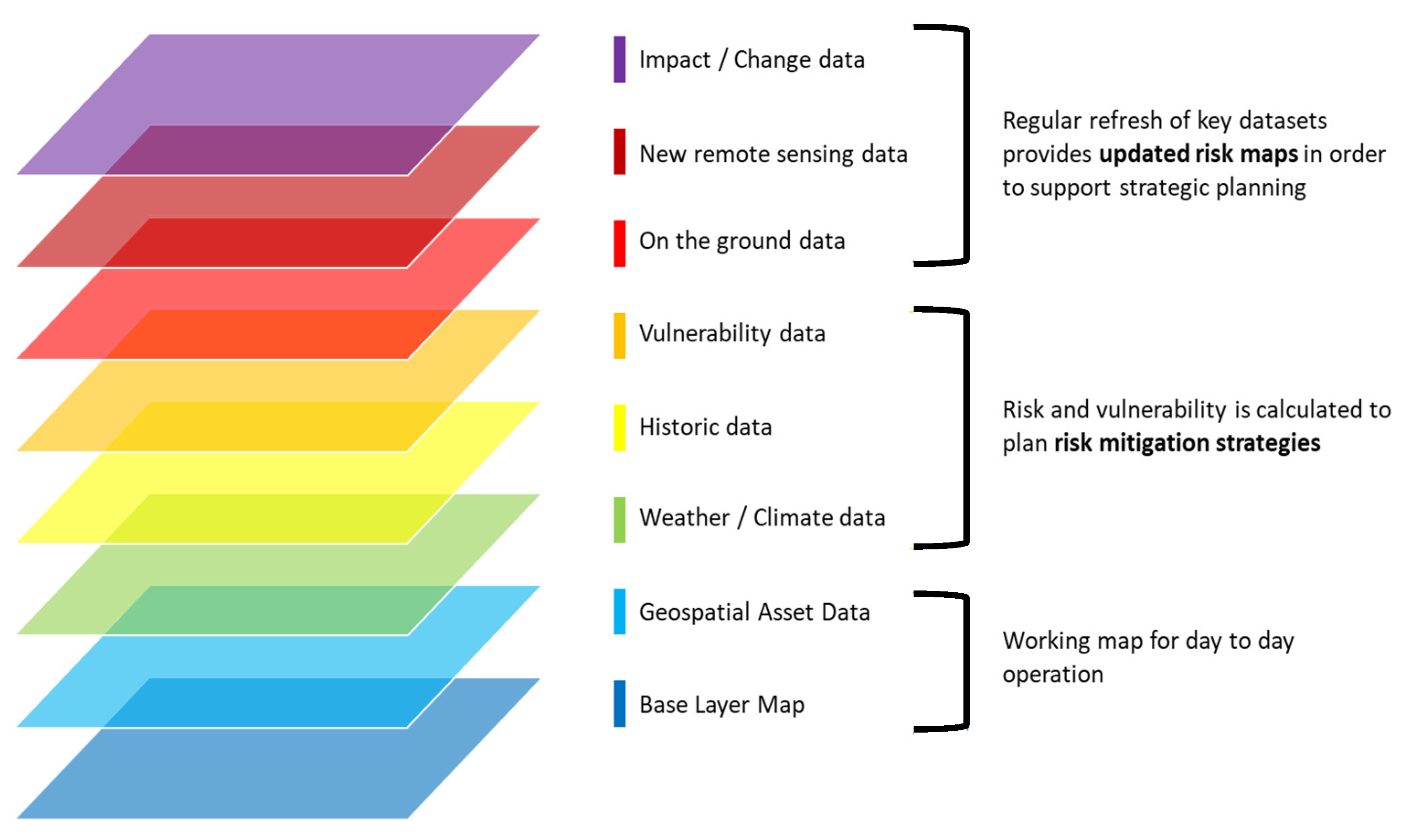

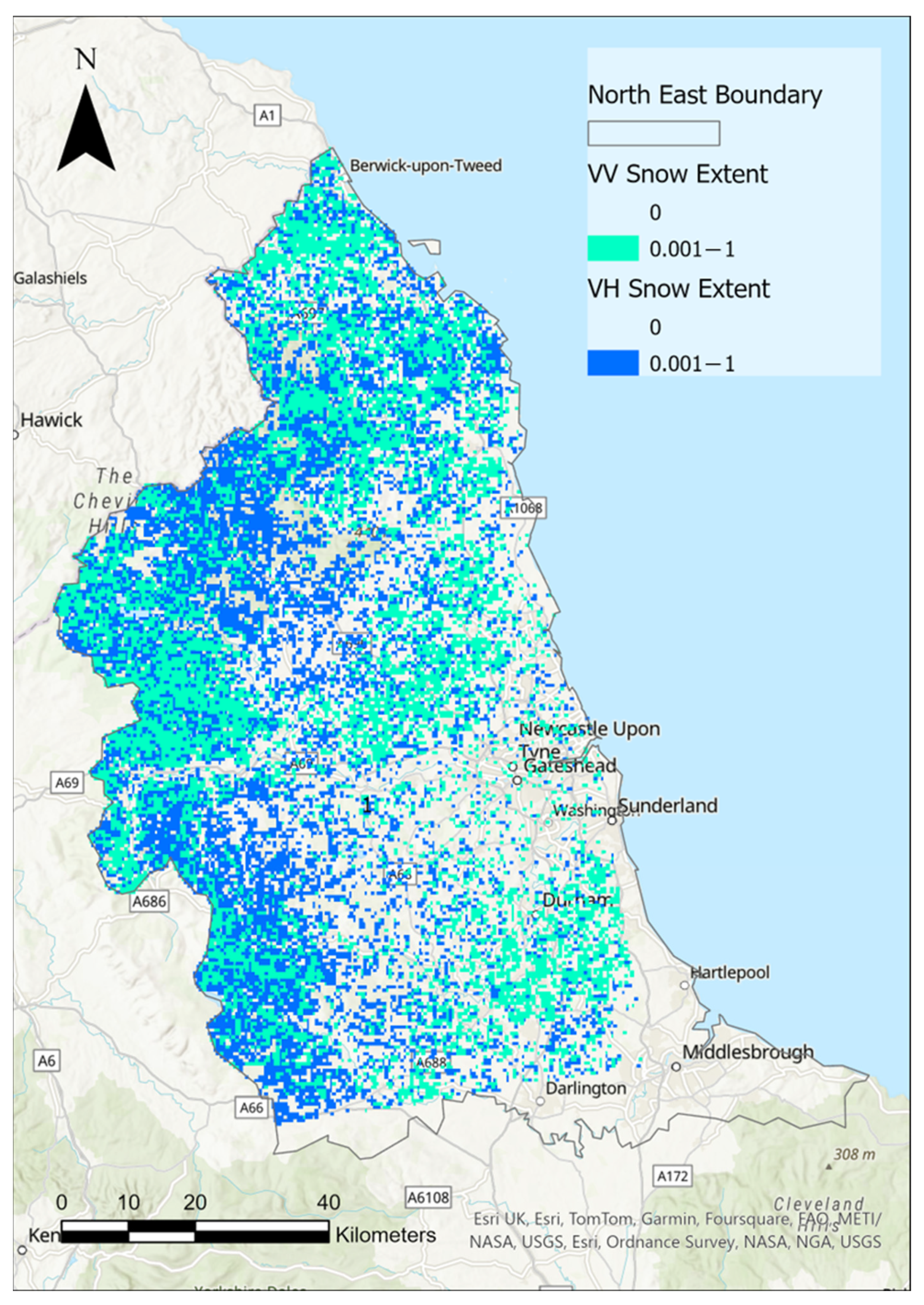
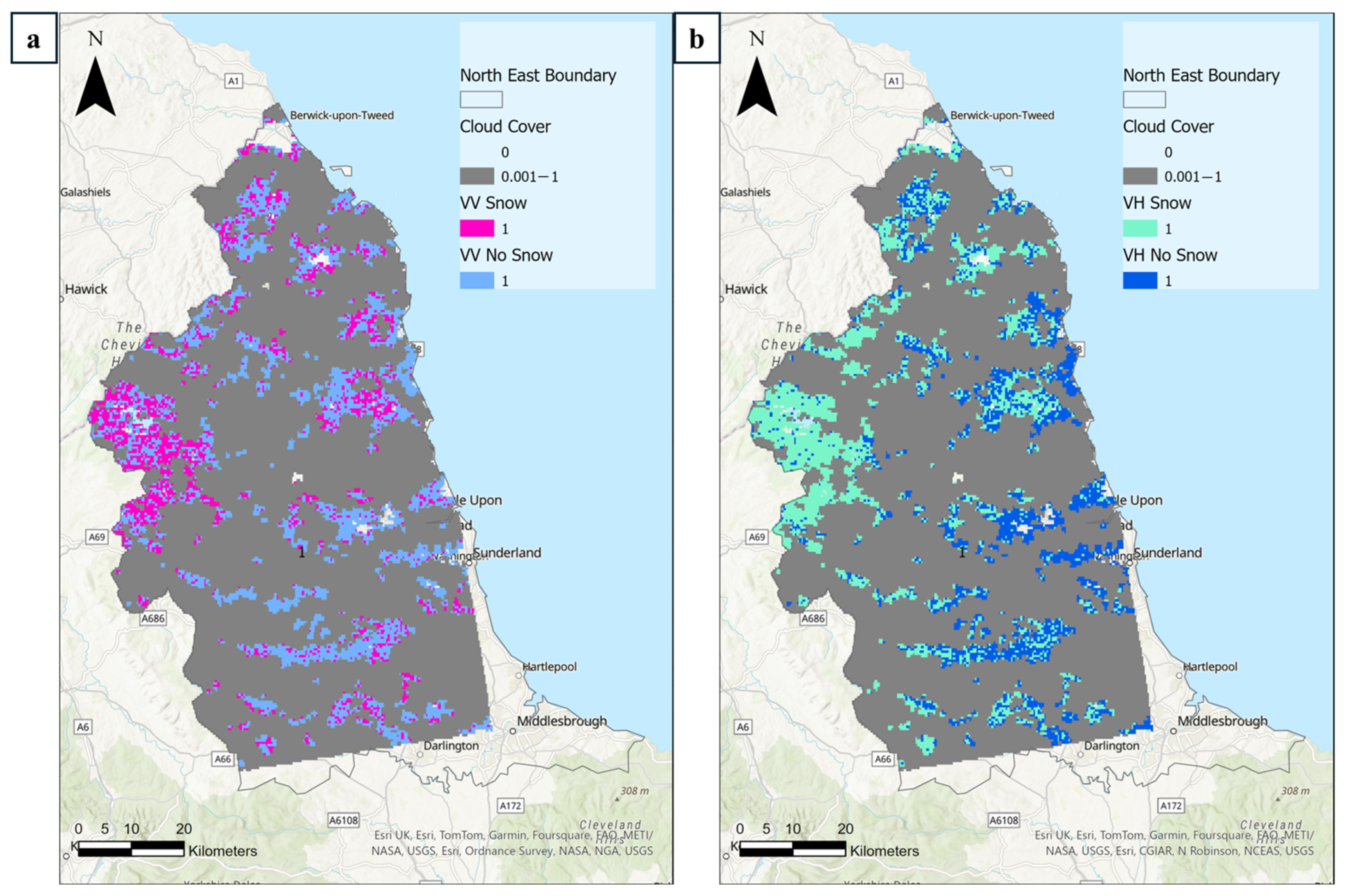


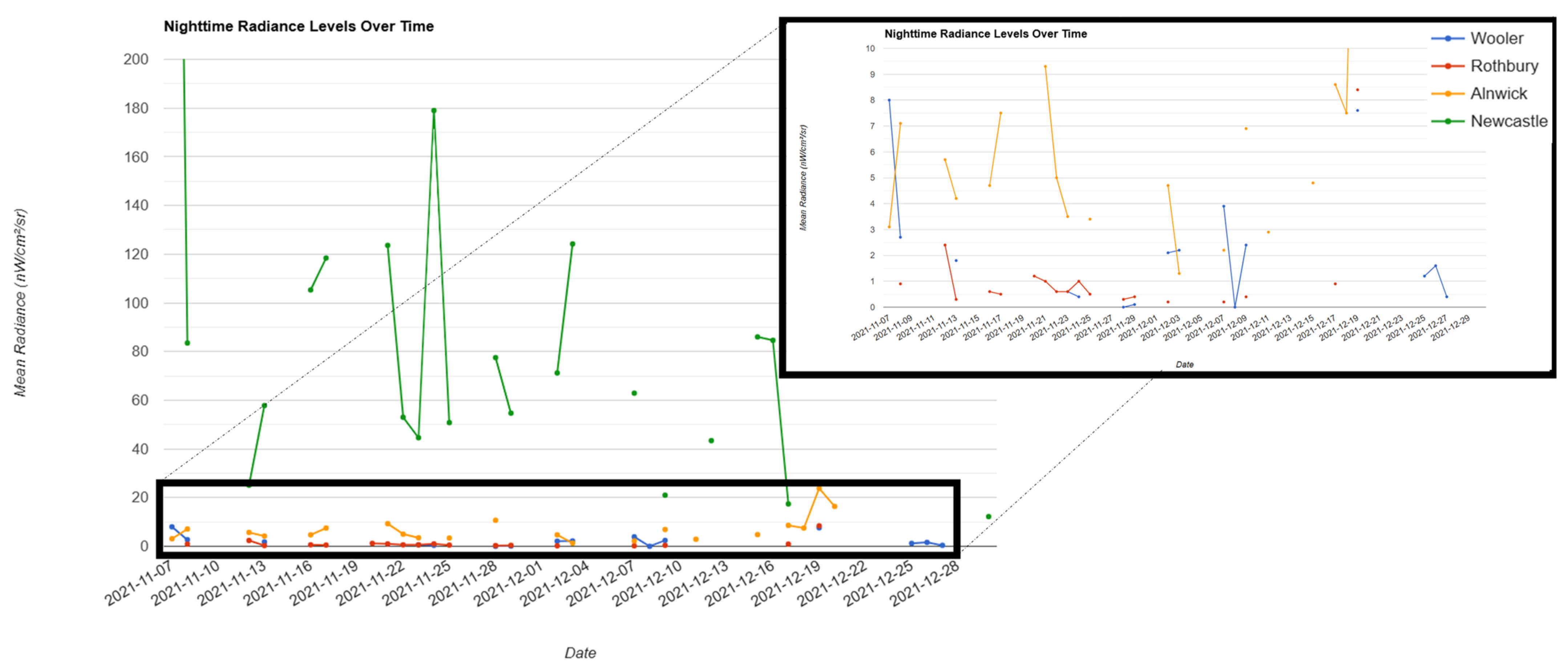

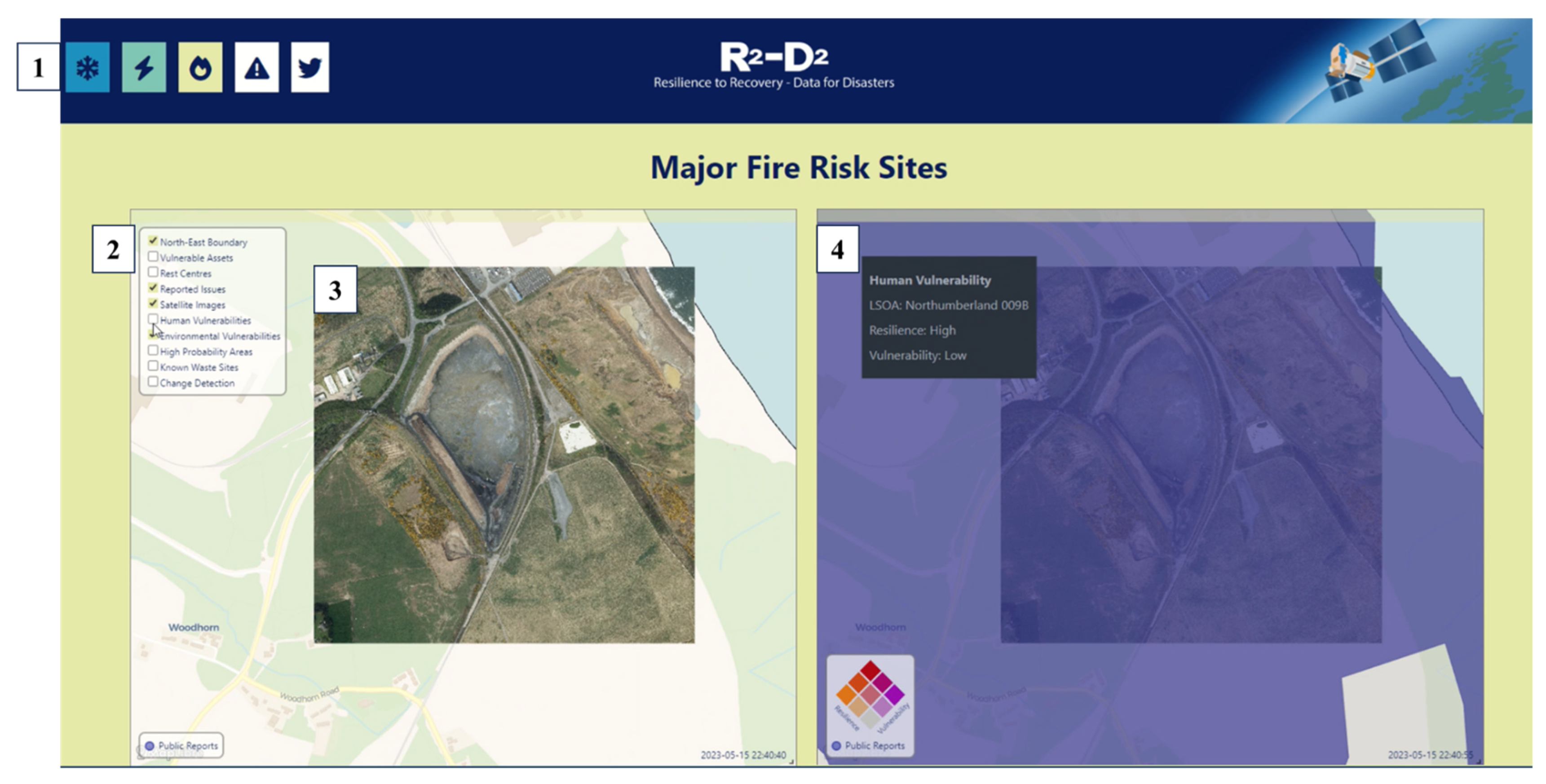

| Dataset | Case Study | Description and Justification |
|---|---|---|
| Satellite imagery | ||
| MODIS NDSI snow cover [59] | Snow/extreme cold | Interferometric Wide Swath (IW) mode in ascending orbit and relative orbit pass 30 from Google Earth Engine (GEE) using the Earth Engine Python API Version 0.1.341. |
| Sentinel-1 [60] | Snow/extreme cold | Analysis-ready data available through GEE. The Sentinel-1 Toolbox applies standard SAR data processing techniques, such as thermal noise removal, radiometric calibration and terrain correction. |
| Sentinel-1 [60] | IWS fire | Using orbital properties that are ‘ASCENDING’, and the relative orbit number 132 to ensure a constant local incidence angle of the images. |
| Further geospatial datasets | ||
| Fire Stations (R2-D2 stakeholder input) | IWS fire | Address gathered from several sources and geocoded. |
| Lower Super Output Area (LSOA) [61] | IWS fire | Used to calculate the percentage area that was covered within the service area and measure resilience based on its accessibility to fire stations. |
| Care home data [62] | IWS fire | The statistics of care homes within an LSOA were joined with the resilience values to visualise a bivariate vulnerability–resilience plot. |
| Northern Powergrid [63] | Electricity transmission faults | Power outage statistics, updated several times daily. |
| Met Office Warnings [64] | Electricity transmission faults | Red, yellow, amber and green warnings, available several times a day. |
| Weather API [65] | Electricity transmission faults | Wind speed, available at 30-minute intervals. |
| NASA Black Marble Nighttime imagery [66] | Electricity transmission faults | Landsat-8 data, available at daily resolution. |
| ERA5-Land [67] | Snow/extreme cold | Provides data on different weather conditions, such as snow cover, snow density, snow depth, snowfall, snow melt and surface temperature. |
| Copernicus Global Land Service: Land Cover 100 m [68] | Snow/extreme cold | Provides spatial information on different classes of physical coverage of the Earth’s surface. |
| OS MasterMap Highways network [69] | Snow/extreme cold | Used to calculate service area network based on driving distance. |
Disclaimer/Publisher’s Note: The statements, opinions and data contained in all publications are solely those of the individual author(s) and contributor(s) and not of MDPI and/or the editor(s). MDPI and/or the editor(s) disclaim responsibility for any injury to people or property resulting from any ideas, methods, instructions or products referred to in the content. |
© 2025 by the authors. Licensee MDPI, Basel, Switzerland. This article is an open access article distributed under the terms and conditions of the Creative Commons Attribution (CC BY) license (https://creativecommons.org/licenses/by/4.0/).
Share and Cite
Wolf, K.; Mills, J.P.; Cormier, L.; Dunn, R.; Fairless, O.; Falaye, A.; Gordon, S.; Jayamanne, O.; Morris-Wiltshire, C.; Myall, E.; et al. Capability Analysis of Earth Observation Data for Integrated Emergency Management. Remote Sens. 2025, 17, 1545. https://doi.org/10.3390/rs17091545
Wolf K, Mills JP, Cormier L, Dunn R, Fairless O, Falaye A, Gordon S, Jayamanne O, Morris-Wiltshire C, Myall E, et al. Capability Analysis of Earth Observation Data for Integrated Emergency Management. Remote Sensing. 2025; 17(9):1545. https://doi.org/10.3390/rs17091545
Chicago/Turabian StyleWolf, Kristina, Jon P. Mills, Luis Cormier, Ruth Dunn, Olivia Fairless, Adewale Falaye, Stuart Gordon, Oshadee Jayamanne, Carrow Morris-Wiltshire, Eleanor Myall, and et al. 2025. "Capability Analysis of Earth Observation Data for Integrated Emergency Management" Remote Sensing 17, no. 9: 1545. https://doi.org/10.3390/rs17091545
APA StyleWolf, K., Mills, J. P., Cormier, L., Dunn, R., Fairless, O., Falaye, A., Gordon, S., Jayamanne, O., Morris-Wiltshire, C., Myall, E., Salgado-Castillo, F., Shukla, Y., Taylor, L., Robson, E., Donoghue, D., Dawson, R. J., Lewis, E., Reaney, S. M., Scott, E., ... Hinds, H. (2025). Capability Analysis of Earth Observation Data for Integrated Emergency Management. Remote Sensing, 17(9), 1545. https://doi.org/10.3390/rs17091545






